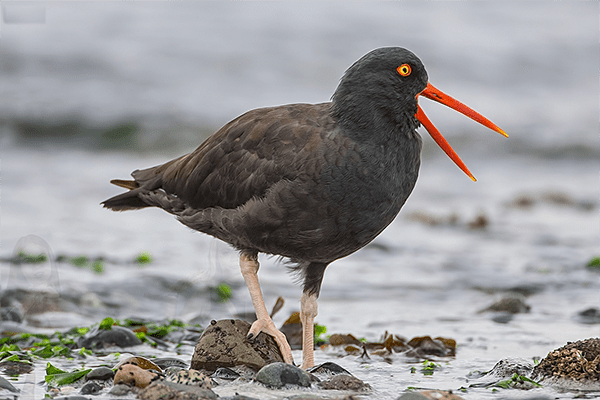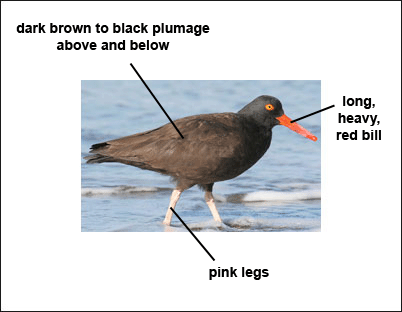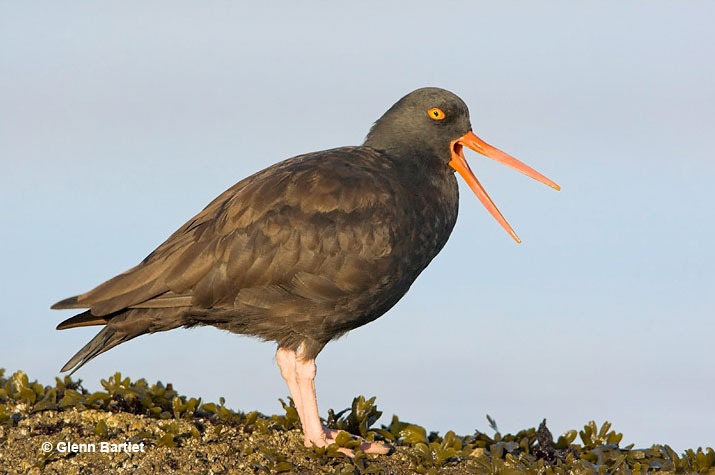The Pacific Coast relative of the American Oystercatcher, the Black Oystercatcher ranges from Alaska to Baja. Generally sedentary, Black Oystercatchers have marine shoreline territories that are used for foraging as well as nesting. Though capable of some swimming, foraging is done by walking in search of clams and other bivalves.
Eggs and chicks are vulnerable to predators and storm surges, though adults are also occasionally taken by predators such as Peregrine Falcons. Breeding doesn’t take place until about age five, and Black Oystercatchers have been known to live more than 15 years in the wild.
On this page
Description of the Black Oystercatcher
BREEDING MALE
The Black Oystercatcher is a large, chunky shorebird that is brownish-black with pink legs and a large, heavy, red bill.

Photograph © Alan Wilson
Female
Same as male.
Seasonal change in appearance
None.
Juvenile
Similar to adults but with pale feather edgings on upperparts.
Habitat
Rocky coastlines.
Diet
Mussels and other shellfish.

Behavior
Forages among the rocks at low tide.
Range
Resident along the west coast of North America. Population stable.
More information:
Bent Life History
Visit the Bent Life History for extensive additional information on the Black Oystercatcher.
Wing Shape
The shape of a bird’s wing is often an indication of its habits and behavior. Fast flying birds have long, pointed wings. Soaring birds have long, broad wings. Different songbirds will have a slightly different wing shape. Some species look so much alike (Empidonax flycatchers) that scientists sometimes use the length of specific feathers to confirm a species’ identification.
Wing images from the University of Puget Sound, Slater Museum of Natural History
Fun Facts
Black Oystercatcher pairs often use the same breeding territory in subsequent years.
Black Oystercatchers sometimes form flocks in the winter, and congregate in areas with a high density of mussels.
Vocalizations
A loud “kee’ or a series of sharp “wee-wee-wees.”
Similar Species
The Black Oystercatcher is unmistakable. Very inexperienced birders might confuse it with the American Oystercatcher or the Black Skimmer because of the large, heavy bill.
Black Skimmer
Black Skimmers have much shorter legs and feed by skimming over the water.
Nesting
The nest is pebble-lined scrape on gravel, grass or a depression in rock on an island.
Number: 2-3.
Color: Pale olive with darker markings.
Incubation and fledging:
– Young hatch at 24-29 days.
– Young fledge (leave the nest) in 1-3 days but remain with the adults for some time.
Bent Life History of the Black Oystercatcher
Published by the Smithsonian Institution between the 1920s and the 1950s, the Bent life history series of monographs provide an often colorful description of the birds of North America. Arthur Cleveland Bent was the lead author for the series. The Bent series is a great resource and often includes quotes from early American Ornithologists, including Audubon, Townsend, Wilson, Sutton and many others.
Bent Life History for the Black Oystercatcher – the common name and sub-species reflect the nomenclature in use at the time the description was written.
HAEMATOPUS BACHMANI (Audubon)
At the northern end of their range, in the Aleutian Islands, I first became acquainted with these big black waders. Here we frequently saw them at various points, as we entered or left the rockbound harbors, sitting in little groups or in pairs on the rocks or outlying ledges. They were surprisingly inconspicuous on the wet and dark colored rocks, which were often half hidden in the prevailing fogs. They seemed to fit very well into their dark and gloomy surroundings. They were not particularly shy, as they stood on the slippery rocks and nodded to us with grotesque dignity, or as they flew out around us uttering their loud and penetrating cries.
Courtship: W. Leon Dawson (1909) writes:
Left to themselves, the birds are no Quakers, and the antics of courtship are both noisy and amusing. A certain duet, especially, consists of a series of awkward bowings and bendings in which the neck is stretched to the utmost and arched over stiffly into a pose as grotesque as one of Cruikshank’s drawings, the whole to an accompaniment of amorous clucks and wails.
Nesting: We did not succeed in finding any nests of the black oyster catcher in the Aleutian Islands, though they undoubtedly breed there. Dr. W. H. DalI (1873) found two nests in the Shumagins on June 23, 1872; there were two eggs “in one nest and one lfl another, if nest it could be called, being simply a depression in the gravel of the beach without even a straw to soften its asperities.” Dr. Wilfred H. Osgood (1901) found a nest in the Queen Charlotte Islands, which “was merely a hollow about 2 inches deep and almost perfectly round, scooped out of a weedy turf a few feet above highwater mark. The bottom of the 110110w was covered with bits of broken stone, evidently placed there by the old bird.”
Referring to the rocky islands off the coast of Washington, Mr. Dawson (1909) says:
The eggs of the black oyster catcher, normally three in number, are oftenest placed in the hollow of a bare rock, lined with a pint or so of rock flakes, laboriously gathered. Occasionally bits of shell, especially the calcareous plates of the goose barnacle, are added by way of adornment. Now and then the wader emulates the gull and prepares a careful lining of grasses. One such nest with three eggs I passed repeatedly, on Carroll, languidly supposing it to be a gull’s until Professor Jones exclaimed over it.
For a nesting site the upper reaches of barren reefs or shoulders are chosen, hut on the smaller rocks, where the waders have exclusive rights, the eggs may be lodged on the very crest of the islet. Again, upon Destruction Island, we found eggs on a coarse beach gravel, where to the protection of color, stone.gray with black spots and blotches, was added the almost perfect assimilation of form to that of the rounded pebbles.
Eggs: The black oyster catcher lays two or three eggs, occasionally only one and more rarely four. They are very much like the eggs of the American oyster catcher, but perhaps they will average a little more huffy. They are ovate in shape and have a very slight gloss. The ground colors vary from “cream buff” to “olive buff.” They are usually quite evenly covered with small spots and scrawls of black or very dark browns, “bister” or “Dresden brown,” and various shades of “Quaker drab.” The measurements of 44 eggs average 56.2 by 39.5 millimeters; the eggs showing the four extremes measure 62 by 39.5, 58.1 by 42, 51 by 39.5 and 54.2 by 37.5 millimeters.
Young: Nothing seems to be known about the period of incubation or whether both sexes share in it; both parents are interested in the care of the young and are very solicitous for their welfare. Dr. Joseph Grinnell (1910) writes:
Dixon observell two half-grown young running about on the beach; but as soon as the old birds, which were always watching, saw anyone approaching a warning note was uttered, at which the young ones promptly squatted among the rocks wherever they happened to be, even if in the edge of the water. They remained perfectly quiet and blended so nicely with their surroundings that it was difficult to locate them even when they had been previously seen from a distance. The old birds attacked and put to rout any gulls or ravens that approached the vicinity.
Prof. Harold Heath (1915) says:
The prececial fledglings very early accompanied their parents on short journeys about the cliffs, and within a week after hatching were observed pecking at limpets, although it is highly probable that for several days thereafter they depended on the old birds for the greater part of their food supply. During this time the young resemble diminutive ostriches, with thick-set legs, big feet, and fluffy plumage, which, it may he added, harmonizes to a high degree with the surroundings. Furthermore, they have the same habit of hiding the head when it is not possible to conceal the entire body beneath a stone.
Plumages: The downy young black oyster catcher is a swarthy little fellow, clothed in short, thick, dark, grizzly down, a color pattern well suited for concealment among the dark rocks where it lives. The down of the upper parts is basally sooty black and very dark gray, but the pale huffy tips give the bird its grizzly appearance. There is an indistinct loral and postocular stripe and two broad, more distinct, parallel stripes down the back of brownish black and two blackish areas on the thighs; between the back stripes and on the rump the buff tips produce a transverse barred effect. The underparts are dull grays, darkest on the throat and breast and lightest on the belly; the sides are faintly mottled or barred.
In juvenal plumage the young bird is much like the adult, but the feathers of the wing coverts, scapulars, tertials, and back are tipped with narrow terminal bars of “cinnamon huff” and subterminal blackish bars; those of the flanks, thighs, and under tail coverts are tipped with the same color; most of these huffy tips soon wear away, and before the postjuvenal molt there are only a few spots left on the wing coverts, scapulars, and tertials, some of which are carried through the winter as evidences of immaturity. I have not seen enough material collected at the proper seasons to trace the molts of adults.
Food: Mr. Dawson (1909) writes:
Even when visiting the mainland shore, which is not often, the bird confines its attention to the barnacle-covered rocks and high-lying mussel beds. Its food consists of marine worms and crustaceans of various sorts, barnacles, limpets, and especially mussels. Its stout, chisel-shaped beak enables it to force an entrance into the most refractory mussel shell and to sever as by a knife the strong adductor muscles, which hold the valves together. Its feet also are large and strong, and the toes are provided with an elaborate set of pectinations which enable the bird to maffitain a footing upon the most slippery rocks. If the foothold on n sloping rock is anywise precarious, the bird retreats backward and uphill by means of these convenient caiks.
A. B. Howell (1917) says:
Certain rocky points are selected by the birds, and to these are often brought the barnacles which they pry off the rocks. These are worked over at leisure, and at one such depot on the Coronados, which I examined there was fnlly a bushel of shells.
Behavior: The flight of the black oyster catcher is strong and direct, hut it seemed to me to he rather slow and heavy. Lucien M. Turner (1886) says:
The flight consists of a few rapid strokes of the wing, followed by a sail for a few yards. It is sluggish when on the wing, and flies with difficulty, and rarely long continued. When alarmed it flies over the water within a few yards of the shore, and in going from one point of rocks to another it either makes the trip in easy stages from one large rock to another, or else follows the Indentations of the shore line. The bird is always on the alert, and not at all shy. It generally sees the hunter long before he suspects the presence of the bird. The bird either squats in a depression of the rocks, or stealthily creeps to the top of some huge bowlder, where it utters a piercing, whistling chatter like that of a policeman’s rattle. It causes the intruder long search to discover the presence of the bird, for its color is so near that of the rocks it frequents that it is not easily detected. The note is then answered by another bird, so that in a few minutes a dozen may be chattering hideously, making the hunter wonder where all the birds came from so suddenly, as all the birds within hearing assemble on the first note of alarm.
Carl Lien says in his notes:
If occasion requires these birds are good swimmers and, if pursued when crippled, will dive deep and long. A very alert bird and always first to give alarm.
Voice: My notes refer to the cries of this bird as loud, penetrating screams, sounding like whee-up, or iokee-ep.
Doctor Dali (1873) says: They utter, when disturbed, a peculiar, low whistle; which once heard, is likely to be remembered; and they have a habit of standing on the beach or rocks a little way apart, and whistling to one another; one calling and the other answering; and keeping it up for half an hour at a time. It Is one of the most peculiar birds of the region, in its motions, having a grave, solemn and stilted gait, and bobbing its head up and down with every step.
Winter: As the black oyster catcher is practically resident all the year round throughout most, if not all, of its range, there is not much to be said about its migrations, though there is probably some shifting of individuals. Doctor Dali (1873) refers to it as a summer visitor in the Aleutian Islands, but Mr. Turner (1886) records it as a permanent resident there.
DISTRIBUTION
Range: Pacific coast of North America and Lower California.
Breeding range: The breeding range of the black oyster catcher extends north to Alaska (Atka Island, Range Island, St. Paul Harbor, Montague Island, Hinchinbrook Island, Sitka, St. Lazaria Island, probably Kuiu Island, Coronation Island, Prince of Wales Island, Forrester Island, and Duke Island); south along the coast of British Columbia (Porcher Island, Skidegate, Vancouver Island, and New Westminster); Washington (Bellingham Bay, Waidron Island, Flattery Rocks, Quillayute Needles, Destruction Island, and Copalis Rock) ; .Oregon (Three Arch Rock, Newport, and Bandon); California (probably Prince Island, Eureka, probably the Farallon Islands, Point Pinos, San Miguel Island, Santa Cruz Island, Anacapa Island, San Clemente Island, and San Diego); and Lower California (Todos Santos, San Benito Island, Cedros Island, Natividad Island, Abreojos Point, and Los Coronados Islands).
Winter range: In winter, the black oyster catcher is found throughout its breeding range except (normally) in Alaska and (probably) northern British Columbia. It has, however, been recorded on one occasion at this season, in Alaska, St. George Island, January 12, 1917 (Hanna).
Migration: An early date of arrival in Alaska is Unalaska Island, April 29, while a late date of departure is St. Lazaria Island, September 30.
Egg dates: Alaska: 14 records, June 5 to 26; 7 records, June 13 to 23. British Columbia: 13 records, May 27 to June 20; 7 records, June 6 to 12. California: 7 records, May 25 to June 10.


